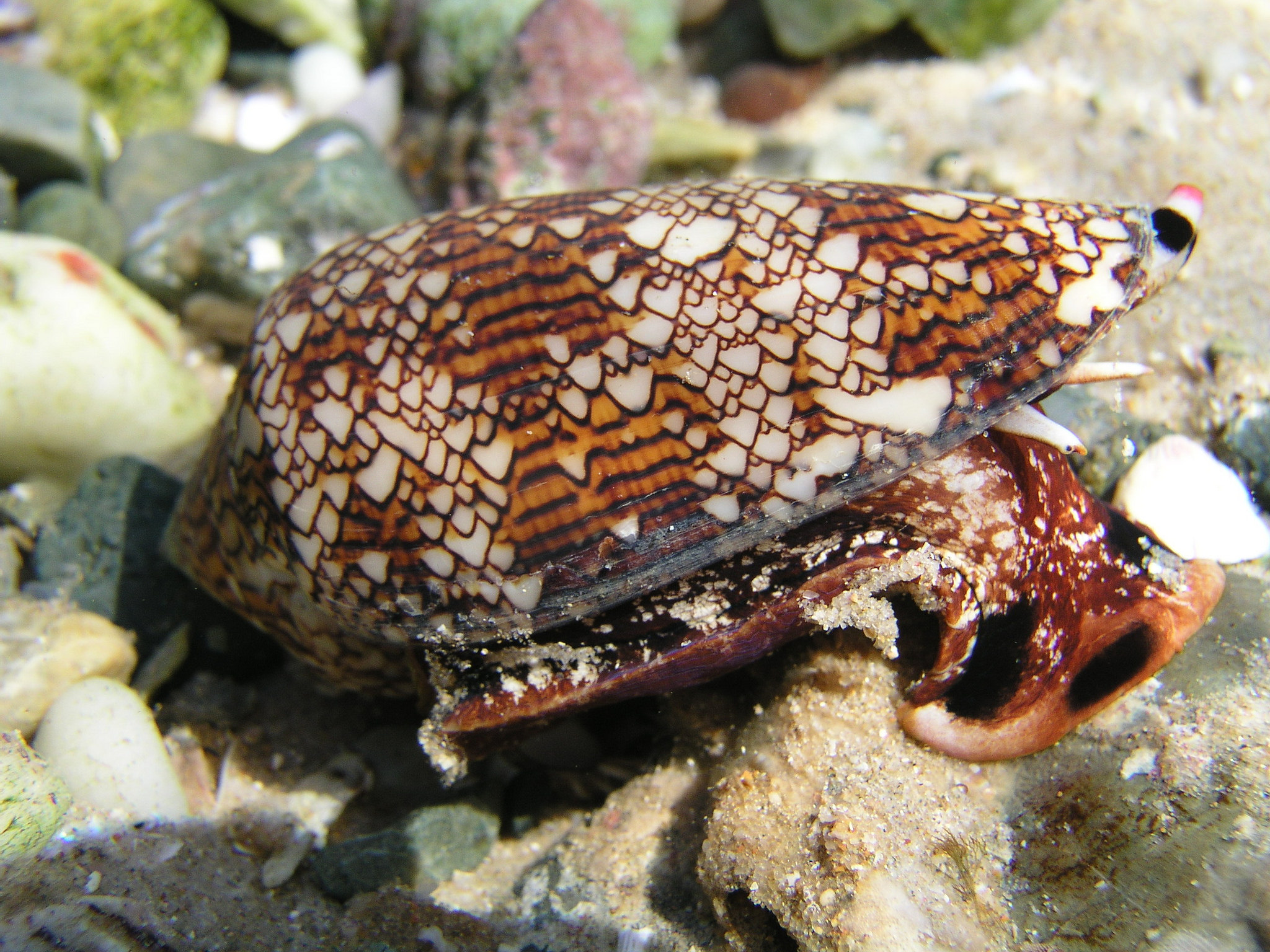
The color and pattern of this beautiful cone is highly variable. There are slight spiral ridges near the base of the shell, and the rest is smooth. The body whorl is convex with rounded or slightly angled shoulders. This marine cone snail has a highly glossy, heavy shell and a short spine with straight or slightly concave sides. The textile cone lives in the sand beneath coral and rocks in shallow waters. Throughout the Indo-Pacific region, Australia, and the Indian Ocean from eastern Africa to Hawaii and French Polynesia. This species is not currently on exhibit at the Aquarium. This article appeared in the Beachcombing Magazine September/October 2021 issue.CLIMATE CHANGE: Not Applicable At the Aquarium No live shelling: Be sure shells are empty and sand dollars, sea stars, and sea urchins are no longer alive before you bring them home. Learn more about identifying shells, the history of seashell collecting, great shelling beaches, and the lives of the animals who make the shells we find on the beach. So the next time you come across one of these beautiful but deadly creatures on a coral reef or a rock shelf, be sure to thank it…from a safe distance! This same group of researchers is also studying using the insulin from conotoxins as a method for treating diabetes in humans.Īll of these studies are only preliminary right now, but they all say the same thing: we humans have a lot to learn from the natural world, even from snails that would harm us to protect themselves. Researchers at the University of Utah are exploring the pain reducers in conotoxins as a new method of painkiller, particularly as a replacement for more addictive painkillers like opioids. The chemical properties of these toxins, if they can be reproduced, may prove useful in creating treatments for Parkinson’s disease, nicotine addiction, and various cancers. A group of biochemists at the National Institute of Standards and Technology is researching the effects of certain conotoxins on the central nervous system of various animals. Maitland (1823-1904), Abraham Oltmans (1811-1873), and the Amsterdam society Natura Artis Magistra.ĭespite the cone snail’s obvious danger, some scientists are learning from the small gastropods in order to make medicines for human illnesses. Tulip cone shells from the Iconographia Zoologica, Th.G. Textile, Striated, Alphabet, and Banded Marble cone shells, Jennie Altman.

There is no antivenom available for cone snail stings. It is always prudent to check any shells you find to make sure there is not someone still living inside, but in the cone snail’s case it is dangerous to even get close to their shells, so look out for a proboscis sticking out of a shell before approaching it. Conus geographus is commonly referred to as the “cigarette snail,” because its human victim will only have time to smoke one cigarette before death.Ĭonus geographus, aka the cigarette snail, Daniela Migliorisi. The smaller cone snail species will only give humans a painful sting, but the larger species like Conus geographus, Conus tulipa, Conus striatus, and other can kill a human with their toxins. Textile cone shell, textile and Hebrew cone shells, Jennie Altman. For humans, that bright color can mean a beautiful shell to add to a collection, but we are not immune to the cone shell’s deadly harpoon.


Like monarch butterflies and coral snakes, cone snails are brightly colored to warn potential predators of their secret venomous weapon. A cone snail’s venom can contain paralytics, numbing agents, insulin to trigger hypoglycemia, pain reducers to lull the victim, and other “conotoxins” that target specific systems in the body.Ĭollection of cone shells, alphabet cone shells, Jennie Altman. The cone snail has a large tooth called a radula that is stored in its proboscis, a long tube-like structure coming out from the snail’s mouth.ĭepending on the species and the type of toxin the snail is using, their methods of hunting prey can vary, but all use their radula as a harpoon that shoots out of the proboscis and deliver the venom to their victim. Each species has its own method and material of venom, but all cone snails are predatory animals, capturing fish and worms in a completely unique way. The cone snail, known by its taxonomic name as the Conidae family, comprises about 1,000 species, inhabiting tropical waters across the world in rocks and coral reefs.

But in another contradiction, these venomous snails may also be the key to saving human lives. But one animal has them all beat: the cone snail may look small and slow-moving, but it is one of the deadliest animals in the ocean, fatal even to humans.
#Textile cone snail full#
The animal kingdom is full of contradictions: birds that don’t fly, prey that can’t see, and marine mammals that can’t breathe underwater.


 0 kommentar(er)
0 kommentar(er)
